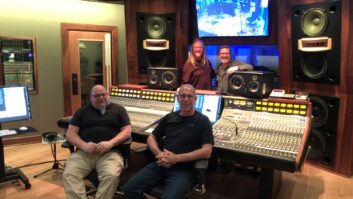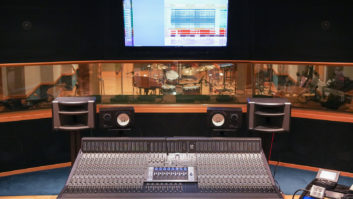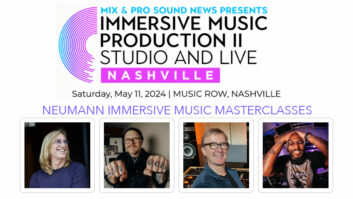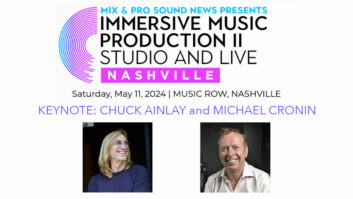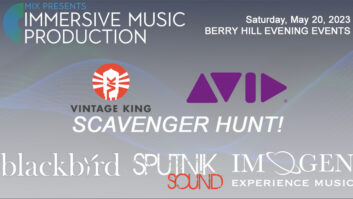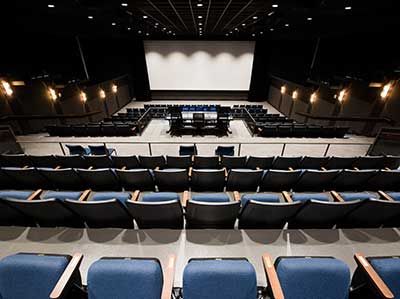
There’s a magic in strolling around a college campus in the early fall, much like the thrill of walking up the ramp to a baseball game at the age of six and seeing a major league field for the first time. The energy, the contained-yet-vibrant environment, and, at least on the campus, the intermingling of so much creative curiosity, as if separate disciplines are bouncing off of each other and everybody wants to partake.
Belmont University, sitting atop Music Row in Nashville and this year celebrating its 125th anniversary, is a living portrait of university life, with its meticulously maintained lawns, student quad, brick buildings and 19-year-olds in a hurry. With the August opening of the new ground-up, four-story complex housing the Mike Curb College of Entertainment and Music Business, it’s also a living portrait of the new music and media industry.
Belmont already had a wealth of recording studios in its range of facilities, both on-campus and at Ocean Way Nashville, Columbia Studio A and Quonset Hut on Music Row, when a new building to house a dining hall was proposed on campus. In early 2013, senior leadership at the university challenged faculty and staff across all departments to come up with ideas for the other three floors.
In March, after surveying faculty and staff, Dr. Wesley Bulla, then dean of the CEMB, submitted a proposal to add Immersive Sound and networked audio facilities to the Audio Engineering Technology program, while at the same time bringing Music Business, Motion Pictures, Media Studies, Songwriting and Entertainment Industry Studies together under one roof.
“We had outgrown our computer labs, offices, and general workspaces, but not necessarily our studio spaces,” Bulla says. “[Belmont] President [Bob] Fisher gave us the charge to ‘dream big,’ ‘think about the future,’ ‘create something new,’ and ‘don’t replicate what we already have.’ Our framework for thinking was, ‘What’s next for the Curb College?’ So we used this as an opportunity to address and meet modern production and teaching/classroom needs, specifically, network-IP based production spaces, emerging immersive audio formats, and collaborative teaching spaces. Plus, the Media Studies and Motion Pictures programs needed updated facilities and a home base.”

The proposal was accepted, and ground was broken on the new 134,000-square-foot R. Milton and Denice Johnson Center in Summer 2013. Roughly 24 months later, the new Curb College debuted, with the first university-based Dolby Atmos stage in the world, pictured on this month’s cover, as its centerpiece. The building also houses a smaller film/TV mix stage, 26 edit suites, a shooting stage, green screen room, video and broadcast control rooms, a Foley stage (coming in the spring), and four computer labs. Media is shared over a 5x 64TB Avid ISIS 5500 server; interconnection is through an advanced Focusrite RedNet system.
COLLABORATION
Audio Engineering Technology and Music Business were already the two largest degree programs in the Curb College, and they had been adequately covered by facilities, albeit in various locations. The growth, then, is all about the future of media production, through the addition of post-production facilities and modern workflows, with collaborative instruction the overriding goal.
“Students in the audio program will learn about film production and how to create audio and sound for film—from small format media to large-screen DCP compliant immersive productions and live events,” Bulla explains. “Students in the film program will learn about audio and sound production and how to incorporate quality sound into their vision for a film. Both students will benefit from working together on film, video, and media projects. Aside from the story/screenplay, the downfall of amateur, semi-pro, and student film production is usually the sound design and quality of the audio production. Our goal is to change that. Student films coming out of Belmont will have great writing, great videography, and equally great sound—not to mention great music.”
“The new studios bring students the opportunity to not only learn how to use the equipment but to learn how it all applies in the real world,” adds Dave Warburton, the recording and film studios manager recently transplanted from NBC/Universal in Los Angeles. “For our Motion Pictures majors, the Johnson Center includes everything you’d find in a modern post facility. They’re able to cut their picture using Media Composer and manage their media on an Avid ISIS server. They’ll cut sound in edit rooms on Pro Tools rigs with industry-standard plug-ins. They’ll take their locked picture to the color-grading suite and use DaVinci Resolve for color correction, compositing, and VFX . They’ll bring it all together to do their final mix in a purpose-built mix stage using the same mix consoles the pros use. We’re talking about implementing classes or labs with a focus on media management and media security, as well as a class about the importance of IT-style networking in rooms and facilities that have more CAT-5 cable than XLR. The goal is for students to be as prepared as possible to start their careers.”
Central to both the teaching methods and the facility operation is the Focusrite RedNet Dante-based network system, with each room serving essentially as a node. “In each of these room-based networks our goal has been to keep the signal flow entirely in the digital realm from source to amp/speaker over the Dante Network,” explains Ron Romano, staff IT specialist. “Each room consists of a RedNet 5 as the interface with Pro Tools, and then we send and receive the audio from other various RedNet devices such as the RedNet 4 mic pres. The RedNet 4s are great because the preamp controls can be integrated into Pro Tools for remote control, allowing the engineer to stay in the session and even recall the settings with the Pro Tools session in the future. From there, each of these Red Net ‘room-based’ networks can be connected together on a larger RedNet network to collaborate from room to room, or in the future, even building to building.”

“Our sound reinforcement students already gain experience in using network audio during our student-produced showcases in the 5,000 seat Curb Event Center,” adds Michael Janas, instructor, Audio Engineering Technology and the director of Recording Studio Operations. “RedNet is a proven platform by which we chose to base our entrance into network audio for studio and post-production.”
FACILITIES
While the entire building is wired for the new world of production, the new Dolby Atmos stage, based around an Avid S6 console and custom JBL monitoring, represents the scope and scale of the entire project.
“We knew we wanted and needed a screening theater and we already knew we needed a large format mixing stage,” Bulla says. “Surround sound was always in the picture. We have been teaching audio for media for years in a music studio adapted for Foley and 5.1 mixing. We were given the charge to ‘dream big’ and ‘think about the future’—immersive sound is the future of film mixing, and object-oriented IT-based audio is the future of sound production. Dolby is the prevalent player in film sound—whether immersive or standard surround in 9.1, 7.1, etc. Atmos was the logical choice. It’s nice to know the facility will serve and enhance multiple programs.”
Both the Atmos stage and a secondary mixing stage are outfitted with 24-fader Avid S6 Fusion consoles. Playback is Pro Tools 12 HD Native and the record system is Pro Tools 12 HDX. Connection between Pro Tools 12 and the S6 is via RedNet 6 MADI units, along with RedNet 5 Pro Tools bridge. JBL speakers, BSS processing and Crown DCi amplification are used in the mixing stages, 7.1 mixing control room, and in the Foley control room. Five 64TB Chassis of Avid ISIS 5500 Server for building-wide media storage are accessible from the Atmos room and every other room, including the 26 edit suites, four computer labs and the video control room on the first floor.
“It was important to us that we looked at the film and recording systems so that rooms were collaborative with each other,” Romano says. “In order to do that we couldn’t just build a great room then go to the next floor and build another great room. We wanted to build great rooms and a great building as part of a great campus. Not only did we standardize on several technologies like RedNet and audio over the Dante Network to achieve this, but also using consoles from the Avid series you can move through this building and work on an S3, an S5 Fusion and an S6 as you progress from room to room. From an educational standpoint, a student can come to Belmont and truly put their hands on the full production experience in one building.”
Doug Howard came aboard as the new dean of the Curb College of Entertainment and Music Business early in 2015, and while he graduated from Belmont in the mid-’70s, spent 30 years on Music Row and has been on the board of advisors for nearly 20 years, he gracefully acknowledges that he walked into a dream. And he properly gave credit where it was due throughout the reporting of this story. We’ll give him the final word.
“When I walk through the halls of the new Johnson Center, I have to think back to my first semester on campus as a student, when we only had one analog 8-track studio located in the basement of the business school. That same semester in 1976, we were all elated to expand to 16 tracks after the purchase of a used Ampex MM1000 thanks to a number of $20 donations made by many of the students. It is an honor to be back on campus to serve as the dean of Curb College, especially at this very special time in the program’s history. Our students, faculty and staff are all so very grateful to the university trustees, president and senior leadership for having the vision and commitment to provide such a world-class facility for the next generation of industry creators and leaders that will graduate from Belmont University.”
THE CORE BUILDERS
Projects of this scale, by necessity, are a team effort, incorporating many talents inside and outside of the university, including the Russ Berger Design Group on studio design and acoustics. The principals involved included:
From the University: Bob Fisher, President; Thomas Burns, Provost; Steve Lasley, CFO; Wesley Bulla, Former Dean, Curb College; Rick Bengtson, Faculty, Media Studies Dept.; Will Akers, Former Chair, Motion Pictures Program; Mike Janas, Director Recording Studio Operations; Ron Romano, IT/Technology Coordinator.
From Outside the University: David Minnigan, Darrell Lambert (Architects, Earl Swenson Associates); Bill Trivett (Construction Design/Budget Supervisor, Earl Swenson Associates); Russ Berger, Richard Schrag (Acoustic Designers, Russ Berger Design Group); M3 Technology Group; Media/Broadcast Integration & Technical Services, Inc. (M/BITS); Marshall Graphics; Vintage King Audio; SimplyMac; Manios Digital Film, Cartoni USA; Tri-State Theater Supply.

